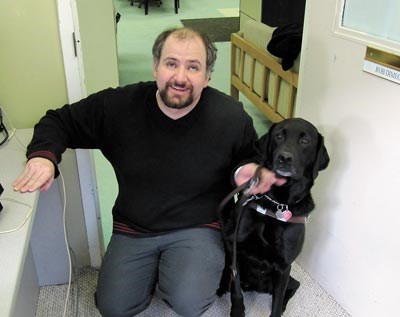Travel can still be a wonderful experience, even if you are disabled, according to Rob DiMeglio, a program manger with Independent Living Sudbury Manitoulin.
DiMeglio, 34, has a degenerative eye disease, which became serious when he was 24 years old.
“I have only five per cent vision,” he said. “I had very good vision when I was young.”
But thanks to Gabe, his seeing eye dog, and helpful transportation staff, he finds he can travel with relative ease.
DiMeglio has flown as far as California where he obtained his dog, a pure breed American black Labrador Retriever.
He has also flown to British Columbia with Air Canada.
He said the fact that he is legally blind and has a seeing eye guide dog makes a big difference when he’s travelling.
“The treatment I get is unbelievable when I travel with Gabe. It is so much easier. He helps to maneuver me around obstacles.”
Staff at airports are very helpful, he said.
“When I go to the Sudbury Airport, they will phone ahead to alert the Toronto airport. They (attendants) will be there to meet me and walk me to the next gate. Then the attendant hands me off to another attendant, and Gabe and I are taken right into the plane.”
Once inside the plane, Dimeglio is taken to his seat first. Gabe then lies down in front of him on the floor of the plane.
DiMeglio finds this kind of treatment is repeated when he takes a Greyhound bus or uses Sudbury Transit locally.
“In the Greyhound bus, Gabe and I get the same treatment. We are let on first and Gabe curls up on the floor in front of me. Then everyone else boards.”
Planning is key when travelling with a guide dog.
“You have to cut their rations of food and water 12 hours before you get on a plane or long distance bus,” the program manager said. “Dogs can go for quite awhile before they need to go.”
His experience when he travels may be due to the fact that there are Canadian regulations for accessible transportation that service companies must follow, according to the Canadian Transportation Agency.
“The personnel training for the Assistance of Persons with Disabilities Regulations require transportation companies to train their employees and contracted personnel on how to provide services to persons with disabilities,” the agency’s website states.
For more information on travelling with a disability, visit the Canadian Transportation Agency at www.otc-cta.gc.ca.
Tips from the Canadian Transportation Agency to make travelling easier
- Plan ahead.
- Determine your needs.
- Obtain information by phone or online about services you can expect.
- Identify which transportation companies can best meet your needs.
- Request written confirmation about your accessibility arrangements when you book your travel destinations.
- Give as much as 48 hours notice to a transportation company.
- Arrange for help in checking in, moving through the terminal, boarding, making connections and disembarking, as well as storing and retrieving luggage.
- Arrange for help in accessing a washroom, transferring from a wheelchair to a seat and moving through customs and
immigration zones.
